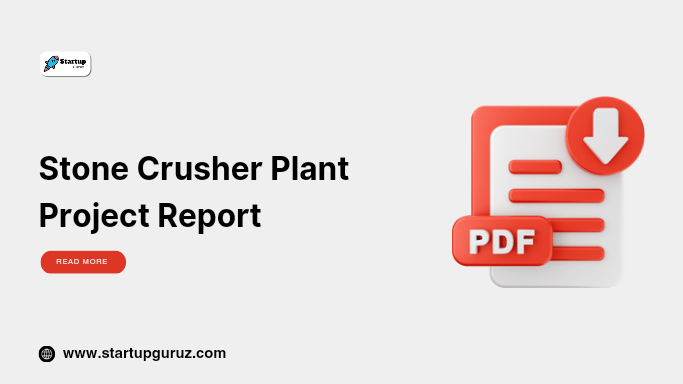Stone Crusher Plant Project Report
Stone Crusher Plant Project Report
A stone crusher plant project report is essential for entrepreneurs planning to establish a stone crushing plant. This comprehensive report provides critical insights into the industry, market trends, financial requirements, and operational plans. Stone crushing is a vital activity in construction and mining industries, offering crushed stone as a fundamental raw material for building infrastructure like roads, bridges, and buildings.
In this detailed guide, we’ll explore the various aspects of a stone crusher plant project, including setup requirements, financials, and frequently asked questions.

Importance of a Stone Crusher Plant Project Report
A well-structured project report serves as a business plan and a tool to secure funding from banks or investors. It outlines the project’s scope, cost, revenue potential, and risk factors, providing a roadmap to ensure business success.
Key Objectives of the Report
- Budget Planning: Helps in calculating initial investment and operating expenses.
- Profitability Analysis: Provides estimates of potential revenue and profit margins.
- Operational Guidance: Acts as a guide for plant setup and production.
- Loan Facilitation: Essential for obtaining bank loans or other financial assistance.
Components of a Stone Crusher Plant Project Report
1. Executive Summary
- Brief overview of the project.
- Objectives and mission statement.
- Key financial highlights and funding requirements.
2. Industry Overview
The stone crushing industry is a key player in infrastructure development and contributes significantly to the global economy.
Market Trends
- Growing demand for crushed stone in construction activities.
- Rising urbanization driving infrastructure development.
- Increasing adoption of automated crushers to enhance productivity.
Setup Requirements for a Stone Crusher Plant
1. Land and Location
- Land requirement: 1-2 acres depending on plant size.
- Proximity to raw material sources and target markets.
- Adequate infrastructure, including roads, water, and electricity.
2. Machinery and Equipment
| Equipment | Estimated Cost (₹) |
|---|---|
| Jaw crusher | 5,00,000 – 10,00,000 |
| Vibrating screen | 3,00,000 – 7,00,000 |
| Conveyor belts | 2,00,000 – 5,00,000 |
| Hopper and feeder system | 1,50,000 – 3,00,000 |
| Dust control systems | 2,00,000 – 4,00,000 |
| Miscellaneous equipment | 1,00,000 – 2,50,000 |
| Total Cost | 14,50,000 – 31,50,000 |
3. Raw Materials
- Stones sourced from quarries.
- Transportation arrangements for raw materials and finished products.
4. Labor and Workforce
- Skilled and unskilled labor for plant operation.
- Operators for machinery and vehicles.
Financials and Cost Analysis
Initial Investment
| Expense | Estimated Cost (₹) |
|---|---|
| Land acquisition | 10,00,000 – 20,00,000 |
| Equipment and machinery | 15,00,000 – 32,00,000 |
| Plant installation | 5,00,000 – 8,00,000 |
| Working capital | 5,00,000 – 7,00,000 |
| Miscellaneous expenses | 2,00,000 – 4,00,000 |
| Total Investment | 37,00,000 – 71,00,000 |
Revenue Potential
| Output | Earnings (₹) |
|---|---|
| Daily production: 100 tons | ₹60,000 – ₹80,000 |
| Monthly revenue | ₹18,00,000 – ₹24,00,000 |
| Annual revenue | ₹2,16,00,000 – ₹2,88,00,000 |
Profitability Analysis
With efficient operations, the stone crusher plant can achieve a profit margin of 20-25% after covering operating expenses. The business is highly profitable with a payback period of 1-2 years.
Marketing Strategies for Crushed Stone
Target Markets
- Construction Companies: For road, building, and bridge construction.
- Government Projects: Supplies for public infrastructure projects.
- Retail Customers: Local demand for small-scale projects.
Promotion Channels
- Partnering with construction firms and contractors.
- Online marketing through B2B platforms.
- Participating in trade fairs and exhibitions.
Challenges and Risk Management
Common Challenges
- Environmental Regulations: Strict laws regarding dust and noise pollution.
- Raw Material Supply: Dependence on quarry operations.
- Market Competition: Price wars with established players.
Mitigation Strategies
- Use eco-friendly dust suppression systems.
- Diversify suppliers to ensure consistent raw material availability.
- Offer competitive pricing with high-quality products.
Environmental and Legal Compliance
Environmental Considerations
- Install dust control systems to minimize air pollution.
- Proper disposal of waste materials.
Legal Approvals
- Quarrying license for raw material sourcing.
- Pollution control board approvals.
- Factory registration and labor compliance.
FAQs
1. What is the primary purpose of a stone crusher plant?
A stone crusher plant processes raw stones into crushed stone, which is used in construction and other industries.
2. How much land is required for a stone crusher plant?
Typically, 1-2 acres of land are needed, depending on the plant’s size and production capacity.
3. What is the initial investment required for a stone crusher plant?
The total investment ranges from ₹37,00,000 to ₹71,00,000, including land, machinery, and working capital.
4. Is stone crushing a profitable business?
Yes, with profit margins of 20-25%, a stone crusher plant can achieve high returns within 1-2 years.
5. What are the major equipment requirements?
Key machinery includes jaw crushers, vibrating screens, conveyor belts, and dust suppression systems.
6. What are the challenges in the stone crushing business?
Challenges include environmental regulations, raw material supply, and market competition.
7. How is the crushed stone marketed?
Crushed stone is marketed to construction companies, government projects, and local contractors.
8. What are the environmental requirements for a stone crusher plant?
Compliance with pollution control norms, including dust suppression and noise control, is mandatory.
9. How is raw material sourced for stone crushing?
Raw stones are sourced from nearby quarries through long-term agreements.
10. What licenses are needed for a stone crusher plant?
Approvals from the pollution control board, quarrying licenses, and factory registration are required.
Conclusion
Starting a stone crusher plant is a lucrative business opportunity, given the growing demand for crushed stone in construction and infrastructure projects. A comprehensive project report helps in planning and executing the venture effectively, ensuring profitability and compliance with environmental and legal norms. Entrepreneurs can achieve long-term success by adopting advanced technologies and efficient marketing strategies.